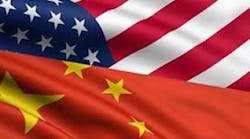The U.S. and Chinese trade imbalances in manufactures continued to surge in 2012, with the U.S. deficit up by 8%, to $498 billion, and the Chinese surplus by 15%, to $755 billion, notes a new report from the Manufacturers Alliance for Productivity and Innovation (MAPI).
For the three years since 2009, the U.S. deficit rose by $172 billion, or 53%, while the Chinese surplus soared by $333 billion, or an extraordinary 79%. The three-year increase in the U.S. deficit resulted in the loss of 700,000 to 1.4 million American manufacturing jobs, including 140,000 to 280,000 jobs in 2012.
In “The U.S. Trade Deficit in Manufactures and the Chinese Surplus Continued to Surge in 2012,” Ernest Preeg, MAPI senior advisor for International Trade and Finance, warns that for the technology-intensive manufacturing sector, which accounts for 75% of U.S. merchandise exports, the trade figures constitute a major competitiveness challenge for the United States.
“Over three years, U.S. manufactured exports grew by $337 billion, or 39%, while Chinese exports were up by $809 billion, or 71%,” Preeg said. “As a result, Chinese exports rose from 31% larger than U.S. exports in 2009 to 62% larger in 2012, and are on track to double U.S. exports by mid-decade. In longer-term perspective, U.S. manufactured exports in 2000 were three times larger than Chinese exports.”
High-technology industries now account for well over half of Chinese exports. In 2012, for the nine largest high-tech industries, Chinese exports of $1,016.3 billion were 50% larger than the $678.3 billion of U.S. exports. For the three essentially IT industries of office, telecommunications, and electrical machinery and equipment, Chinese exports of $697.7 billion were more than three times larger than the $206.7 billion of U.S. exports.
According to the report, the most striking dimension of the U.S.-China trade relationship is the extremely lopsided bilateral trade account. In 2012, U.S. imports of manufactures from China were $417 billion, or 6.3 times larger than the $66 billion of U.S. exports to China, and up from a ratio of 6.1 in 2011. U.S. exports to China were flat in the second half of 2012 while imports were up by 5%.
“Looking ahead, the momentum is toward still larger trade imbalances in 2013,” Preeg predicted. “Less clear but far more important is the longer-term outlook over 5 to 10 years. Opinions vary as to whether the U.S. deficit in manufactures will continue to rise or begin to fall, but it is highly unlikely, on current policy course, that there will be a major decline in the deficit.”
Indeed, Preeg argues, a strong case can be made for a bolder and more forward-looking U.S. policy response to bring U.S. trade in manufactures back into balance. The policy point of departure is that mercantilism is defined as a strategy to achieve a balance of exports over imports, with the deficit-generating impact on trading partners called “beggar-thy-neighbor.” Not only China, but the other three principal exporters of manufactures—the EU, Japan and South Korea—all have very large trade surpluses in manufactures, while the United States is the outstanding beggarly neighbor. Moreover, all four trading partners have current account surpluses, while the United States has an unsustainably large deficit.




